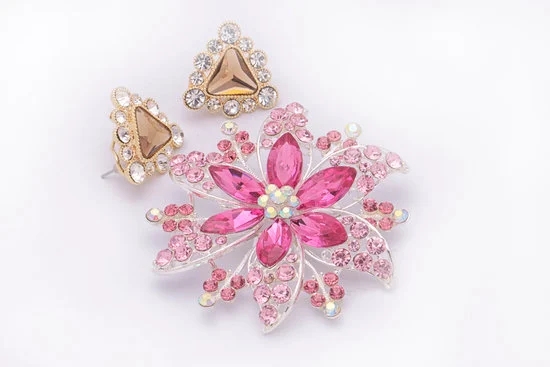Diamonds have long been synonymous with luxury, beauty, and everlasting elegance. The allure of diamond jewelry lies not only in its exquisite craftsmanship but also in the timeless beauty and prestige it embodies. From engagement rings to necklaces, bracelets to earrings, diamonds hold a special place in our hearts and play a significant role in defining our personal style.
In recent years, there has been an increasing demand for personalized diamond jewelry that reflects individual tastes and unique stories. Gone are the days when traditional designs were the sole choice for adornment. Today, people crave one-of-a-kind pieces that capture their personality and celebrate their journey. By learning how to make diamond jewelry, you open up endless opportunities to create stunning masterpieces that resonate with your own artistry as well as the desires of others.
Not only does diving into the world of diamond jewelry making offer creative fulfillment, but it also presents exciting potential for profit. As personalized accessories continue to gain popularity, customers are willing to invest in handcrafted pieces that tell a meaningful story. By honing your skills in this art form, you can turn your passion into a viable business opportunity while delivering exceptional craftsmanship and unique creations to those seeking something truly special.
So if you’re enchanted by the glittering beauty of diamonds and yearn to unlock your creative potential, it’s time to embark on this captivating journey into the world of diamond jewelry making. In the following sections of this article, we will explore everything from understanding the characteristics and grading of diamonds to acquiring essential tools and materials for creating stunning pieces.
Get ready to discover your inner artist as we delve into the intricacies of design concepts, setting techniques, polishing methods, and scaling up your business. The possibilities are endless; let us guide you on this enchanting path towards making dazzling diamond jewelry that will captivate hearts around the world.
Exploring the world of diamonds
Diamonds are incredibly precious and highly sought after gemstones, making them the perfect choice for creating exquisite jewelry pieces. However, before you embark on your diamond jewelry making journey, it is essential to understand the characteristics and grading of diamonds. This knowledge will not only ensure that you select high-quality diamonds for your pieces but also enable you to educate your customers about the value of their purchase.
The 4 C’s: Cut, Color, Clarity, and Carat Weight
The 4 C’s – cut, color, clarity, and carat weight – are the universally accepted standards for assessing diamond quality.
- Cut refers to how well a diamond has been shaped and faceted. A well-cut diamond reflects light in captivating ways, enhancing its brilliance.
- Color is an important factor when evaluating a diamond’s quality. Diamonds range from colorless to colored varieties such as yellow or pink.
- Clarity refers to the presence of any internal or external flaws in a diamond. The fewer imperfections there are, the higher the clarity grade.
- Carat weight measures the size of a diamond. Larger diamonds generally have a higher carat weight and are more valuable.
Diamond Certifications
To guarantee that you are purchasing genuine diamonds and accurately assessing their quality, it is crucial to look for certifications from reputable organizations such as GIA (Gemological Institute of America) or AGS (American Gem Society). These certifications provide detailed information about each diamond’s 4 C’s and ensure transparency in the diamond market.
Identifying Genuine Diamonds
Unfortunately, scams involving fake diamonds do exist in the market. To avoid falling victim to these scams, it is important to familiarize yourself with techniques for identifying genuine diamonds. Basic tests include checking for reflections within the stone or using professional tools like a loupe or a diamond tester.
By understanding these characteristics and grading systems, you will be better equipped to select the right diamonds for your jewelry designs and provide accurate information to your customers, ensuring their trust in your expertise.
Essential tools and materials for diamond jewelry making
When it comes to creating diamond jewelry, having the right tools and materials is essential. Whether you are just starting out or have some experience in jewelry making, having a comprehensive list of tools can help ensure that you have everything you need to bring your designs to life. Here are some essential tools and materials for diamond jewelry making:
- Pliers: Pliers are one of the most basic and versatile tools used in jewelry making. They come in various types such as round-nose pliers, chain-nose pliers, and flat-nose pliers. These tools are used for bending wires, making loops, and holding small components.
- Wire cutters: Wire cutters are used to cut wires or metal findings to the desired length. They come in different sizes and styles, including flush cutters that provide a clean and straight cut.
- Jewelers’ saw: A jewelers’ saw is a handheld tool used for cutting intricate shapes and designs into metal sheets or wires. It allows for precise cuts and is especially useful for creating unique settings or decorative elements.
- Diamond burrs: Diamond burrs are small rotary tools with abrasive surfaces made of diamond particles. They are used for engraving, shaping metal, drilling holes, and adding texture to jewelry pieces.
- Files: Files are essential for refining edges, smoothing surfaces, and shaping metal components. They come in various shapes (flat, round, half-round) and grits (coarse to fine).
- Soldering equipment: Soldering is a technique used in jewelry making to join metal components together using solder (a metal alloy). Essential soldering equipment includes a torch, flux (to prevent oxidation), solder pick (to hold the solder), and soldering block (to protect the work surface).
- Setting tools: Setting diamonds requires specialized tools such as prong pushers or bezel pushers to secure the stones in their settings. These tools help ensure that the diamonds are securely held while minimizing the risk of damage.
- Loupe: A loupe is a small magnifying tool used by jewelers to inspect gemstones, diamonds, and intricate details in jewelry pieces. It allows for close examination and precise work.
Having the right tools is only part of the equation; you also need quality materials to create stunning diamond jewelry. Some essential materials include:
- Genuine diamonds: Selecting diamonds with the desired cut, color, clarity, and carat weight is crucial for creating high-quality diamond jewelry. It’s important to source diamonds from reputable suppliers who provide certification for authenticity and quality.
- Metal findings: Depending on your design, you may need metal findings such as ear wires, jump rings, clasps, bezels, or prongs. These findings come in various metals like gold, silver, platinum, or stainless steel.
- Gemstones: In addition to diamonds, incorporating other gemstones into your designs can add color and uniqueness. Choose from a wide variety of gemstones based on their durability and quality.
- Settings: From prong settings to bezel settings and everything in between, selecting the right setting will ensure that your diamonds are securely mounted while enhancing their beauty.
- Additional materials: Other materials that may be needed include solder (for soldering), polishing compounds (for finishing), adhesives (for gluing components together), and various grades of sandpaper or polishing cloths.
Having these essential tools and materials will provide you with a good foundation for starting your diamond jewelry making journey. As you gain more experience and explore different techniques, you can expand your collection of tools and experiment with new materials to further enhance your designs.
Acquiring diamond jewelry making skills
Acquiring diamond jewelry making skills is an essential step on the path to becoming a skilled jewelry maker. While some may be naturally inclined towards creativity and craftsmanship, others may need to acquire the necessary knowledge and techniques through formal education or self-learning. In this section, we will explore different options for acquiring diamond jewelry making skills, whether it’s through enrolling in classes or pursuing self-education.
Benefits of learning from professionals in jewelry making schools or workshops
Enrolling in jewelry making schools or workshops can provide aspiring jewelers with a solid foundation in the craft. These institutions offer structured courses that cover various aspects of diamond jewelry making, including design, metalwork, stone-setting techniques, and polishing. Learning directly from experienced professionals allows students to gain valuable insights into industry best practices and master essential skills.
The hands-on nature of these classes also provides students with ample opportunities to practice their techniques under the guidance and mentorship of instructors. Additionally, attending these schools allows students to collaborate with peers who share similar interests and aspirations. Networking within the industry can lead to valuable connections and future collaborations.
Online resources, courses, and tutorials for self-education
For those who prefer a more flexible approach to learning or have limited access to physical schools or workshops, there are abundant online resources available that cater specifically to diamond jewelry making. Numerous websites offer video tutorials, step-by-step guides, and educational articles on various aspects of the craft.
Online courses and virtual workshops provide structured learning experiences that can be completed at one’s own pace. These courses often include comprehensive modules covering different techniques required for diamond jewelry making. Some platforms even offer personalized feedback from instructors to ensure proper skill development.
Additionally, social media platforms like YouTube and Instagram host numerous channels dedicated to teaching and sharing tips on diamond jewelry making. Following experts in the field can provide inspiration as well as useful insights into specific techniques or projects.
Practicing the basics and refining techniques through hands-on experience
Regardless of whether one chooses formal education or self-education, the key to acquiring diamond jewelry making skills lies in consistent practice. Practicing the basics is essential for building a strong foundation, and as one becomes more proficient, they can move on to more advanced techniques.
Setting aside dedicated time for regular practice allows aspiring jewelers to refine their techniques and gain confidence in their abilities. Experimenting with different materials, stones, and settings can help expand one’s skill set and push creative boundaries. The process of trial and error is crucial in discovering new techniques and finding one’s unique style.
Sourcing diamonds and gemstones ethically and sustainably
In today’s socially-conscious world, consumers are increasingly concerned about the ethical and sustainable sourcing of materials. This holds true for diamond jewelry as well. As a diamond jewelry maker, it is important to prioritize ethically and sustainably sourced diamonds and gemstones to support responsible mining practices and protect the environment. Here are some key points to consider when sourcing your materials:
- Importance of ethical sourcing: Ethical sourcing in the diamond industry refers to the assurance that the diamonds are obtained through fair labor practices, without exploiting workers or contributing to conflict zones. By choosing ethically sourced diamonds, you can ensure that your creations are not associated with human rights abuses or negatively impacting communities.
- Industry certifications and programs: Look for certifications such as the Kimberley Process Certification Scheme (KPCS), which prevents conflict diamonds from entering the market. Additionally, programs like Responsible Jewellery Council (RJC) set high standards for social, environmental, and ethical practices in jewelry supply chains. These certifications provide reassurance that the diamonds you use have been responsibly sourced.
- Diamond alternatives: If you are passionate about sustainability but still want to work with beautiful stones, consider alternative options such as lab-grown diamonds or moissanite. Lab-grown diamonds have the same physical characteristics as mined diamonds but are created in a controlled environment without harmful environmental impacts or unethical practices.
By consciously sourcing your materials from ethical and sustainable sources, you not only play a part in supporting responsible practices but also align yourself with an increasing number of consumers who value sustainability. Making this choice can add value to your brand and appeal to customers who seek jewelry that reflects their values.
Examples
- The Kimberley Process Certification Scheme (KPCS): Established in 2003, this certification process prevents conflict diamonds from entering international markets.
- Responsible Jewellery Council (RJC): Promotes responsible, ethical, social, and environmental practices throughout the jewelry supply chain.
- Lab-grown diamonds: These diamonds have the same physical and chemical properties as mined diamonds but are created in a laboratory setting without the negative impacts associated with mining.
Designing your first diamond jewelry piece
Designing your first diamond jewelry piece is an exciting and creative process that allows you to showcase your personal style and craftsmanship. From concept to creation, this section will guide you through the steps involved in bringing your ideas to life.
To begin, it’s important to brainstorm and sketch out your jewelry designs. Consider the type of piece you want to create, whether it’s a necklace, ring, bracelet, or earrings. Think about the overall style, shape, and aesthetic elements you want to incorporate. Take inspiration from existing designs or create something entirely unique.
Once you have a rough idea of what you want to create, it’s time to take accurate measurements. This step is crucial for ensuring that your final piece fits well and looks balanced. Consider different diamond sizes and how they will be incorporated into your design. Take into account any additional stones or settings that may be included.
To help visualize your design, consider utilizing computer-aided design (CAD) software and 3D printing technology. CAD software allows you to create detailed digital renderings of your jewelry piece, giving you a better understanding of how it will look in real life. 3D printing can then be used to create precise prototypes or wax molds that will serve as a template for casting the final piece.
After finalizing your design and measurements, it’s time to move on to selecting the diamonds and gemstones that will adorn your jewelry piece. Consider factors such as color, clarity, cut quality, and carat weight when choosing diamonds. Additionally, explore different types of stones if you want to incorporate other gemstones into your design.
Jewelry making techniques for diamond setting and mounting
When it comes to creating diamond jewelry, the setting and mounting play a crucial role in showcasing the beauty of the gemstones. In this section, we will explore some common techniques used in diamond setting and mounting, providing step-by-step guidance and tips for success.
- Prong Setting: The prong setting is one of the most popular techniques for securing diamonds in jewelry. It involves using metal prongs to hold the stones in place. The number of prongs can vary depending on the design and desired level of security. This technique allows light to enter the diamond from all angles, maximizing its brilliance.
- Bezel Setting: A bezel setting involves enclosing the entire circumference of the diamond with a metal rim. This technique offers excellent protection for the stone while also giving a sleek and modern look to the jewelry piece. Bezel settings are particularly suitable for diamonds with lower clarity as they can hide any imperfections.
- Pave Setting: The pave setting is all about creating a dazzling display of small diamonds set closely together, covering an entire surface area like a pavement. To achieve this technique, small holes are drilled into the metal, and tiny diamonds are carefully placed into each hole before being secured with beads or prongs. This creates an illusion of continuous sparkle and adds brilliance to any jewelry piece.
- Channel Setting: Channel setting involves placing multiple diamonds side by side within a channel made in the metal band or frame without any visible gaps between them. This technique is commonly used for engagement rings or eternity bands where stones need maximum protection against daily wear.
To ensure successful diamond setting and mounting, it is essential to have proper tools at hand such as prong pushers, claw pliers, bezel rollers, burnishers, etc. These tools allow jewelers to work with precision while avoiding any damage to the stones or surrounding metal.
Remember that practice makes perfect when it comes to diamond setting. Take the time to refine your skills, and always double-check measurements and settings before securing the diamonds in place. With patience and perseverance, you can create stunning diamond jewelry pieces that showcase the brilliance of these precious gemstones.
Polishing and finishing touches for diamond jewelry masterpieces
Polishing and finishing touches play a vital role in transforming diamond jewelry pieces into true masterpieces. This section will guide you through the process of achieving a mirror-like polish and adding professional finishing touches to your creations.
First, it is important to understand the various techniques involved in finishing diamond jewelry. Burnishing and filing are common techniques used to smooth rough surfaces or remove any imperfections from the metal. Burnishing involves using a polished tool, such as a burnisher or agate stone, to create a smooth and shiny surface on the metal. Filing, on the other hand, uses a file to shape and refine the metal before polishing.
Next, achieving a mirror-like polish is crucial for enhancing the brilliance of your diamonds. Start by using sandpaper with progressively finer grits to remove scratches and achieve a smooth surface. Then, move on to using polishing compounds specifically designed for precious metals and diamonds. Apply these compounds onto felt or cloth wheels and use them with your rotary tool or bench grinder to buff the metal until it shines.
In addition to polishing, you can also add extra embellishments or engravings to further enhance your diamond jewelry piece. These details can include intricate patterns, textures, or personalized messages that make your creation even more unique and meaningful. Consider using engraving tools or laser engraving machines for precision and consistent results.
Remember, practice makes perfect when it comes to polishing and adding finishing touches to your diamond jewelry pieces. Take your time to experiment with different techniques and materials until you achieve the desired results. Don’t be afraid to seek guidance from experienced professionals or fellow jewelry makers who can offer valuable advice based on their own experiences.
By mastering the art of polishing and adding finishing touches, you will elevate your diamond jewelry pieces from mere creations to true works of art that shine with brilliance and elegance.
Scaling up your diamond jewelry business
Scaling up your diamond jewelry business requires effective marketing and selling strategies to reach a wider audience and generate sales. In this section, we will explore several key steps to help you promote and sell your creations successfully.
Firstly, it is crucial to establish an online presence to showcase your diamond jewelry pieces. Create a professional website that features high-quality images of your designs, along with detailed product descriptions and pricing information. Ensure that your website is user-friendly and easy to navigate, allowing potential customers to browse through your collection effortlessly. Additionally, consider setting up an online store where customers can make purchases directly from your website.
Social media platforms can be valuable tools for marketing your diamond jewelry business. Set up accounts on popular platforms such as Instagram, Facebook, and Pinterest to showcase your designs and engage with potential customers. Use visually appealing imagery and compelling captions to capture the attention of viewers and encourage them to visit your website or contact you for inquiries. Collaborate with influencers or jewelry bloggers in the industry who can help promote your brand to their loyal followers.
In addition to online efforts, consider partnering with local jewelry stores or galleries to display and sell your creations. Establishing relationships with established businesses not only exposes your work to a wider customer base but also provides credibility and trustworthiness for potential buyers. Attend trade shows or craft fairs in your area where you can exhibit and sell your diamond jewelry pieces directly to interested buyers.
Pricing strategy plays a crucial role in the success of any business. Conduct market research on similar diamond jewelry pieces to determine appropriate pricing points for your creations. Consider factors such as materials used, labor involved, uniqueness of designs, and target market preferences when setting prices. It may also be beneficial to offer promotional deals or discounts periodically as a way of attracting new customers or stimulating sales during slower periods.
By implementing these marketing and selling strategies effectively, you can significantly scale up your diamond jewelry business. Remember that building a successful brand takes time and effort, so be patient and persistent. Continuously adapt your strategies based on market trends and customer feedback to ensure your business remains relevant and profitable.
Conclusion
In conclusion, the art of diamond jewelry making offers a world of endless possibilities and creative expression. By following the steps outlined in this guide, you can embark on a journey from a beginner to a skilled jewelry maker. Embracing this craft not only allows you to create beautiful pieces that are personalized and unique but also provides an opportunity for financial gain.
Throughout this article, we have explored the allure and value of diamond jewelry, diving into the characteristics and grading system that defines their quality. We have discussed the essential tools and materials needed for diamond jewelry making, as well as various ways to acquire the necessary skills through education and practice.
Furthermore, we have emphasized the importance of ethical sourcing when it comes to diamonds and gemstones, promoting responsible mining practices. Additionally, we have delved into designing your first piece from concept to creation, showcasing different techniques for diamond setting and mounting.
Finally, we have touched on polishing and finishing touches that elevate your pieces to true masterpieces. We’ve also provided insights into marketing strategies and selling your creations successfully.
In summary, diamond jewelry making is not only about creating beautiful pieces; it is about realizing your creative potential and passion in a highly rewarding way. Whether you choose to pursue it as a hobby or turn it into a successful business venture, this art form offers personal satisfaction and financial rewards. So, take the leap, embrace the world of diamond jewelry making, and let your creativity sparkle like never before.
Frequently Asked Questions
How do I get started in the diamond industry?
To get started in the diamond industry, it is essential to have a thorough understanding of the industry and its various aspects. Begin by conducting research on diamond grading, certification, and sourcing. Consider acquiring education or certification from reputable institutions to gain credibility and expertise.
Networking is key in this industry, so attending trade shows, joining professional organizations, and building connections with suppliers, manufacturers, and retailers can be beneficial. It is also important to identify your target market and develop a business plan that includes strategies for marketing, sales, and customer service.
Is diamond jewelry business profitable?
The profitability of the diamond jewelry business can vary depending on various factors. While there is potential for high-profit margins in the diamond industry due to its luxury status and strong demand, there are also challenges to consider. Factors such as fluctuating diamond prices, competition from online retailers, marketing costs, overhead expenses, and economic conditions can impact profitability.
Building a reputation for quality and customer trust is crucial for success in this business. A well-executed marketing strategy targeting the right audience can help attract customers willing to pay a premium for high-quality diamond jewelry.
How much does it cost to start a diamond business?
The cost of starting a diamond business can vary significantly depending on multiple factors like the scale of operations, location, inventory selection, equipment requirements, marketing expenses, and legal considerations. Establishing a retail store will typically require significant upfront investment compared to an online-only business model with lower overhead costs.
The inventory alone can range from thousands to millions of dollars depending on the size of your intended operation and product selection strategy (e.g., natural diamonds vs lab-grown diamonds). Additionally, expenses associated with certifications/licenses fees,

Welcome to my jewelry blog! My name is Sarah and I am the owner of this blog.
I love making jewelry and sharing my creations with others.
So whether you’re someone who loves wearing jewelry yourself or simply enjoys learning about it, be sure to check out my blog for insightful posts on everything related to this exciting topic!





